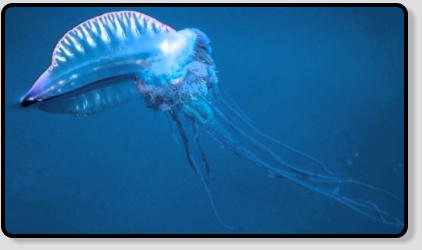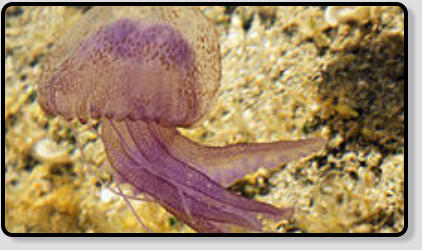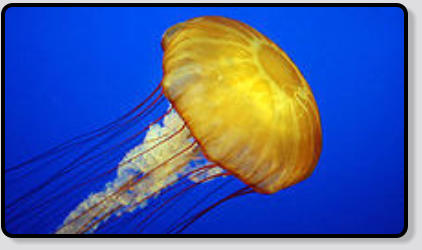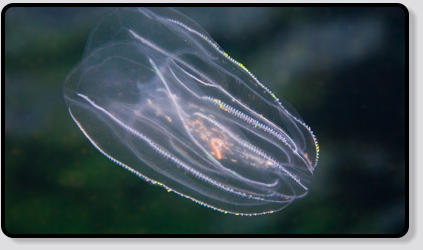Scientific classification
Kingdom:
Phylum:
Cnidaria
Class:
Hydrozoa
Order:
Siphonophorae
Family:
Physaliidae
Genus:
Physalia
Species:
P. Physalis
Binomial name (link Wikipedia)




Portuguese Man of War
Frégate Portugaise
Portugiesische Galeere
Aguaviva-Fragata Portuguesa
Portugees Oorlogsschip

Description
The Atlantic Portuguese man o' war (Physalia physalis), also known as the man-of-war, blue bottle, or floating terror, is a marine hydrozoan of the
family Physaliidae found in the Atlantic Ocean, as well as the Indian and Pacific Oceans. Its venomous tentacles can deliver a painful (and
sometimes fatal) sting. Despite its outward appearance, the Portuguese man o' war is not a jellyfish but a siphonophore, which, unlike jellyfish, is
not actually a single multicellular organism, but a colonial organism made up of specialised individual animals called zooids or polyps. These
zooids are attached to one another and physiologically integrated to the extent that they are unable to survive independently, and therefore have
to function as if they were a so-called individual animal. The Indo-Pacific Portuguese man-of-war (P. utriculus), or blue bottle, is a related very
similar-looking species found throughout the Indian and Pacific Oceans.
The Atlantic Portuguese man o' war lives at the surface of the ocean. The gas-filled bladder, or pneumatophore, remains at the surface, while the
remainder is submerged. As the Portuguese man o' war has no means of propulsion, it moves according to the winds, currents, and tides.
Although it is most commonly found in the open ocean in tropical and subtropical regions, it has been found as far north as the Bay of Fundy and
the Hebrides.Strong winds may drive them into bays or onto beaches. Often, finding a single Portuguese man o'war is followed by finding many
others in the vicinity. They can sting while beached; the discovery of a man o' war washed up on a beach may lead to the closure of the beach

Animalia
Scientific classification
Kingdom:
Phylum:
Cnidaria
Class:
Scyphozoa
Order:
Semaeostomeae
Family:
Pelagiidae
Genus:
Pelagia
Species:
P. Noctiluca
Binomial name (link Wikipedia)




Jellyfisch
Méduse
Leuchtqualle
Medusa
Parelkwal

Description
Pelagia noctiluca (Forsskal, 1775) is a jellyfish in the family Pelagiidae. In Latin, pelagia means "of the sea", nocti stands for night and luca
means light; thus, Pelagia noctiluca can be described as a marine organism with the ability to glow in the dark.
This species of jellyfish, known in Europe as the mauve stinger amongst many other common names, is widely distributed in all warm and
temperate waters of the world's oceans, including the Mediterranean Sea, Red Sea and Atlantic Ocean. It is also found in the Pacific Ocean, with
sightings in warm waters off Hawaii, southern California and Mexico, as well as other Pacific locations.
The body is radially symmetrical. There is only one body cavity known as the gastrovascular cavity. This is a primitive gut or digestive cavity with
only one opening that is used for ingestion and excretion; there are four long oral arms with crenulated margins that are the primary feeding
surface. Each P. noctiluca medusa has 8 long tentacles that emerge from the umbrella margin. Being radially symmetrical it has no head and
thus no centralized nervous system. The nervous system present is primitive, consisting of a simple net composed of naked and largely non-
polar neurons. In addition P. noctiluca also lacks a gaseous exchange, excretory and circulatory system. However cnidaria have evolved cnidae,
cells which serve for a variety of functions that include prey capture, defense, locomotion and attachment. When fully formed cnidae are called
cnidocytes. When stimulated the cnidae secrete nematocyst toxins that are biological poisons.
Animalia
Scientific classification
Kingdom:
Phylum:
Cnidaria
Class:
Scyphozoa
Order:
Semaeostomeae
Family:
Na.
Genus:
Na.
Species:
Escifomedusa
Escifomedusa
Binomial name




Jellyfisch - Escifomedusa
Méduse - Escifomedusa
Qualle - Escifomedusa
Medusa- Escifomedusa
Kwal - Escifomedusa

Description
No further information available on Wikipedia.
Animalia


Harry van Goor 2016
source: Wikipedia, the free encyclopedia


Categories: Jellyfisch



Scientific classification
Kingdom:
Phylum:
Cnidaria
Class:
Ctenophora
Order:
Na.
Family:
Na.
Genus:
Na.
Species:
Na.
Ctenophora
Binomial name




Comb-Jellies
Ctenófore
Rippenqualle
Ctenóforo
Ribkwal

Description
No further information available on Wikipedia.
Animalia

